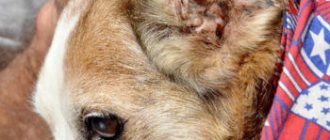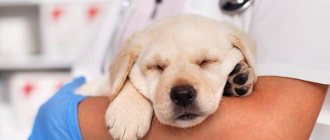Diseases of the cardiovascular system in humans are ubiquitous, but do dogs get heart attacks? As a rule, animals very rarely suffer from heart disease, and a heart attack is no exception.
But according to recent research, it turns out that this seemingly human disease is increasingly occurring in dogs. This is due to many reasons, environment, nutrition, stress, breed predisposition and much more.
Myocardial infarction is a lesion of a section of the heart due to a disruption in its blood supply, as a result of which the affected part becomes necrotic.
Causes of heart attack and stages in dogs
The only cause of a heart attack, in fact, is a disruption of the blood supply to a certain area of the heart muscle. Therefore, we will consider the reasons why blood stops flowing to the tissues of the heart.
Cholesterol plaques
This is an accumulation of a fat-like substance, cholesterol, in the blood vessels. A cholesterol plaque gradually clogs the coronary artery, resulting in oxygen starvation in the myocardium (heart muscle), the tissue does not receive oxygen, muscle function is disrupted, and tissue necrosis gradually begins, which does not receive arterial blood (oxygen-saturated blood).
The location of the infarction depends on where the plaque is located in the vessel, since the coronary artery branches into many small vessels.
If cholesterol does not completely clog the vessel, i.e. If there is a small gap left for blood to pass through, coronary artery disease develops.
Coronary artery disease is an acute or chronic damage to the heart muscle, which is caused by a decrease in the supply of arterial blood to the tissue.
If ischemia persists for a long time and develops from the acute stage to the chronic stage, then necrosis develops as a final result.
Hormonal imbalance
Hormonal imbalance is a rare cause of heart attacks, but because of this it should not be ruled out altogether. A slight increase or decrease in hormones causes an imbalance in the body, sometimes it does not appear, but this does not mean that it does not exist. Changes in hormonal levels can normally be observed with age-related and physiological changes.
A lack or excess of hormones of the adrenal cortex, the adrenal medulla and the thyroid gland leads to various changes throughout the body, in all systems, and the cardiovascular system is no exception; heart failure develops, which leads to a heart attack.
Other reasons
Malignant or benign neoplasms can lead to compression of blood vessels, which will lead to poor circulation or its complete absence.
Infectious diseases of viral or bacterial origin lead to the development of verrucous (warty) endocarditis.
Parasitic diseases . A common heart parasite in animals is dirofilaria, which causes the parasitic disease dirofilariasis. Small worms that migrate to the heart and develop there until the sexually mature stage, when there are a large number of them in the vessel, cause its blockage.
Vasculitis is an inflammation of the vessel wall, as a result of which the lumen of the vessel decreases, possibly leading to the development of coronary artery disease.
Which doctor treats splenic infarction?
Any disease can be completely cured only if it is diagnosed at the initial stage of development. But even here you can find your shortcomings, for example, in the fact that the initial stage of a heart attack is not accompanied by any clearly expressed symptoms.
For this reason, a person consults a doctor already at an advanced stage of development, when conservative treatment is not effective. In order to diagnose the disease in a timely manner, it is recommended to systematically visit a specialist for control diagnostics of the whole body.
If a splenic infarction is diagnosed, treatment with conservative methods consists of following a proper diet and daily routine. Among the medications, it is worth highlighting painkillers, which are prescribed to patients without fail.
In addition to traditional methods of therapy, traditional treatment is also actively used, but it is immediately worth noting that this is completely ineffective, even at the initial stage of the development of the disease. To a greater extent, this is a treatment for “self-soothing.”
If you rely entirely on treatment at home with folk remedies, you can not only start the course of the disease, but also cause quite serious consequences that cannot be treated conservatively.
If the size of the organ damage is large, surgery cannot be avoided. Given how extensive the damage is, either partial or complete removal of the organ may be necessary. In the latter case, there must be a rupture of the spleen.
If treatment of splenic infarction is necessary, it is first recommended to consult a hematologist. This specialist deals with blood problems, but can also help with damage to this organ. If conservative therapy is not possible, then surgical intervention will be required.
Stages of a heart attack
- Pre-infarction or prodromal stage (from a couple of hours to a month).
- The most acute stage (from the moment of ischemia to the first necrotic changes).
- Acute stage (necrosis formation, 2-10 days).
- Subacute stage (scar formation, granulation tissue replaces necrotic tissue).
- Post-infarction stage (scar thickening, heart muscle fully adapts to new changes).
With timely diagnosis, proper treatment and good care, a dog’s life can be significantly extended after a heart attack.
Symptoms of the disease
The owner of the animal must always be on guard of the health of his pet, therefore he must know how and what signs appear in this pathology.
The first symptoms of a heart attack
- The animal is inactive, lies most of the time, is reluctant to go for a walk, and does not play.
- Shortness of breath is rapid and difficult breathing that occurs with any minor physical activity or simply while walking.
- Cyanosis of the mucous membranes (cyanosis) - due to impaired heart function, venous blood does not have time to “leave” the tissues, and arterial blood does not enter it.
- The owner may notice a change in gait; the dog will sway from side to side.
- The animal does not sleep well and sometimes whines in its sleep.
- The dog experiences weakness, sometimes fainting, and refusal to feed.
Pain and behavior change
In the area of the left olecranon, dogs experience severe pain; they lie down on their right side, try in every possible way to reduce the pain - lick the area where the pain is located, whine with sudden movements, make unnatural movements, some dogs try to attract the attention of the owner. If there is severe pain in the left area, one can even limp, thereby minimizing the pain.
Arrhythmias
Arrhythmia is a disturbance in heart rhythm. At the slightest change in the heart muscle, this will be reflected in its work. And the first thing that will change is the heart rhythm; its disturbance can be recognized in two ways: the veterinarian will listen to the heart rhythm using a stethoscope or using electrocardiography (ECG).
There are several types of arrhythmia: bradyarrhythmia, sinus bradycardia, atrioventricular block, atrial asystole and others.
Diagnostics
Diagnosing heart attacks is extremely difficult even for a good veterinarian, since the clinical signs are nonspecific and more indicative of pulmonary failure.
If the animal is predisposed to diseases of the cardiovascular system, then it is worth differentiating a heart attack from heart diseases with similar clinical signs. You should contact a specialist with a narrow focus, namely a cardiologist. In veterinary clinics, a comprehensive examination is carried out, which includes:
- general blood and urine analysis;
- electrocardiography;
- echocardiography;
- systematic pressure measurement;
- Ultrasound.
It should be remembered that a heart attack is a lesion of a section of the heart, and a stroke is a lesion of a section of the brain or spinal cord.
Diagnosis of the condition
It is possible to make a correct diagnosis and start treatment on time only in a specialized clinic. The veterinarian-cardiologist will first conduct a clinical examination of the pet and perform tonometry. A simple and effective diagnostic tool in veterinary practice is the electrocardiography method. A certified specialist will not only perform the procedure, but will also correctly interpret the instrument readings.
On an ECG with pathology, as a rule, deviations of the RS-T segment, an increase in the amplitude of the T and Q waves are noted. Blockade of the Hiss bundle branches and ventricular arrhythmia are also observed.
Taking an ECG with obaki
For diagnostic purposes, echographic examination and ultrasound examination of the myocardium are also used. The methods allow us to assess the state of coronary blood flow, identify vasculitis and determine the presence of a blood clot.
The most informative diagnostic method is angiography. However, the study involves the risk of using anesthesia and is used infrequently in veterinary practice.
For the purpose of differential diagnosis, a clinical and biochemical blood and urine test is prescribed to a sick pet.
Treatment and first aid
Treatment is carried out comprehensively, the following drugs are prescribed:
- antianginal drugs, improve the supply of oxygen to the heart (nitroglycerin, used only if recommended by a doctor!);
- drugs to maintain the heart muscle (adrenaline, caffeine);
- anticoagulants to prevent blood clots (heparin);
- vitamin and mineral supplements;
- dietary nutrition (exclusion of fatty foods).
Do not self-medicate. An animal that has had a heart attack should be kept at a veterinary clinic for 24-hour monitoring.
First aid
If your dog is suspected of having a heart attack, first aid should be provided immediately. How can we help our pet?
The first thing to do is to lay the animal on its side, raise its head slightly up, and lower its paws down if there is severe shortness of breath. The room where the animal is located should be cool and have access to fresh air. If you have a tonometer at home, measure the dog's blood pressure; if it is not low, give a nitroglycerin tablet (to relieve shortness of breath). If possible, call a veterinarian at home, or transport the dog to the clinic as soon as possible.
Normal blood pressure in dogs depends on the breed.
Treatment of heart attack in animals
If your pet has already been diagnosed with a heart attack, then you should know how to deal with it correctly. The doctor will prescribe you an individual prescription according to which you will be treated, approximately it will include the following drugs.
Antianginal
Such drugs are needed to help the heart function. They reduce the amount of oxygen, and this will be enough for it to work. The effect of such a drug will help with shortness of breath. It will not take away the pain itself.
Therefore, this drug is taken only when the doctor has prescribed it. It is necessary to control the dog's blood pressure when he takes this drug. If the pressure is deviated from the norm, then taking nitroglycerin will only worsen the situation.
Medicines that support heart function
The name speaks for itself. This category of drugs supports the work of the heart muscle; the principle of their action is that they stimulate the work of muscle tissue, and it contracts better and nerve impulses are transmitted. Here you need to be careful with the dosage. If you overdo it even just a little, the consequences can be lethal.
Anticoagulants
Heparin and similar substances must be taken in order to prevent blood clots in animals. When a blood clot appears, it breaks off and immediately clogs the vessel. This can happen anywhere. This is not only the heart, but also the brain, kidney and any other organ. When taking these drugs, the blood does not clot, and, accordingly, blood clots do not form.
Prevention
The best treatment for a disease is its prevention. Therefore, to keep your pet healthy, you should follow simple rules: proper and balanced nutrition, with the addition of vitamin and mineral supplements. Eliminate fatty foods from your diet!
Physical activity must be appropriate for the animal; excessive exercise negatively affects not only the heart, but the entire body as a whole, and insufficient exercise combined with poor nutrition will lead to the formation of excess cholesterol in the body. It is important to have your pet undergo a full annual examination by a veterinarian, who can promptly identify any changes.
Prevention and predisposition
Prevention of myocardial infarction in dogs is to not forget about preventive examinations with a veterinarian. Blood tests, urine tests, periodic ECG (especially if there is a predisposition to this disease).
- Do not overload your pet (no need to chase the animal to the point of exhaustion).
- Monitor the animal's emotional state. Stress and fear will not bring you any good.
It is impossible to say that there are any specific breeds that suffer from myocardial infarction. There is a predisposition, that is, in some breeds this disease is registered more often than in others.
Large breeds
In the first place are representatives of large breeds. For example, Newfies, St. Bernards. Necrosis of the heart muscle occurs due to the fact that physical activity on these beauties is chosen incorrectly. Excessively intense ones can lead to heart disease.
Miniature breeds
In second place, as the complete opposite of the first, are representatives of small (miniature) breeds. Pinschers, miniature poodles and other decorative dogs. And why? And because of excessive emotionality. Well, these little dogs behave too impulsively, they are often scared of everything (every rustle or loud sound leads to fear, stress and even excessive aggression). The heart begins to pound, wears out faster.
What diseases can be confused with?
Myocardial infarction is difficult to diagnose and easily confused with other diseases. Let's look at some of them:
- Pulmonary embolism is a blockage of the lumen of the trunk or branches of the pulmonary artery by a thrombus/embolus.
- A dissecting aortic aneurysm is a rupture of the aorta (the largest vessel), blood enters the layers of the aorta and dissects them.
- Acute pericarditis is inflammation of the serous membrane of the heart.
- Spontaneous pneumothorax is the penetration of air into the pleural cavity.
- Unstable angina is a period of development of coronary heart disease.
- Non-cardiac causes.
Nutrition and care after a heart attack
As already written above, a dog after a heart attack needs dietary nutrition:
- eliminating large amounts of fat from the diet;
- complete exclusion of sweets;
- adding vitamins and minerals to the diet;
- adding fermented milk products to the diet.
Care:
- reduction of physical activity, especially for sporting or hunting dogs;
- visiting a veterinarian to monitor the animal;
- careful mating of the animal or its exclusion on the recommendation of a doctor;
- sometimes count the number of heartbeats.
Self-medication or failure to see a doctor in a timely manner can result in death.
Dogs that may be considered at risk
In first place we have dogs of large breeds, such as Newfoundlands, Great Danes and St. Bernards. It is because of improper physical activity that these breeds suffer greatly. The complete opposite is dogs of small breeds, in other words - dwarf dogs. This includes pinschers, poodles, Pekingese and many other breeds. Since these dogs are very gentle, they are often exposed to stressful situations and various nervous breakdowns, they require a lot of attention and care.
Of course, the older the pet, the more often it has health problems. Therefore, we will give third place to dogs in adulthood. It is very difficult for them to fight viruses and various diseases, and they are also not immune from heart attacks. Remember, no matter what breed your dog is, it still needs care. It’s not for nothing that they say that we are responsible for those we have tamed. Love your dogs and take care of their health, because they are our most faithful friends!
Currently reading:
- The American Cocker Spaniel is an adroit hunter and loyal friend.
- Tips for proper dog burial
- Games to choose for training a dog
- Recommendations for obedience of a dog if it growls











